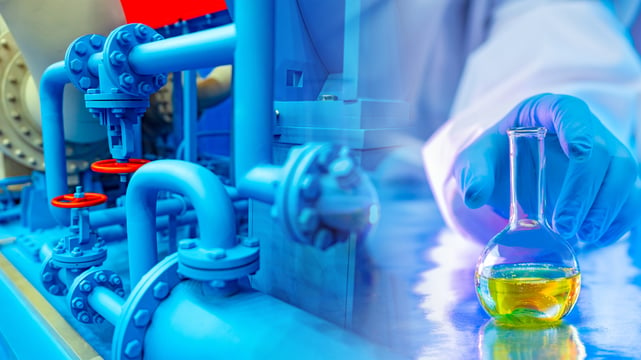Share this
Spot Sampling vs Gas Analyzer: Is it Time for Bay Area Refineries to Make the Update?
by Morgan Zealear on 8/6/20 8:45 AM

Refineries around San Francisco, CA have to be especially on their toes when it comes to sampling for emissions because oversight agencies like the Bay Area Air Quality Management District (BAAQMD) will audit to make sure their stringent monitoring requirements are met. That’s why a variety of new health, safety, and environment (HSE) regulations over the past few years, ranging from the Environmental Protection Agency’s (EPA) Refinery Sector Rule to ever-evolving local requirements, have increased the use of gas analyzers.
But is it worth it to make an make the gas analyzer purchase, too, for your unit? The answer: It depends.
Let’s go through the pros and cons of spot sampling vs gas analyzers so you can get a feel for which type will work best for your specific refinery processes and applications.
Weighing Spot Sampling vs Gas Analyzer Appropriateness
Whether you continue with an upgraded spot sampling method or move on to gas analyzers will depend on cost considerations, placement needs, accessibility, and sample timing. So, let’s do an apples to apples comparison with those requirements in mind to see how each stacks up for your needs.
We’ll start with what’s most familiar—spot sampling.
Pros and cons of spot sampling
Spot sampling is used extensively for testing wastewater basins and process fluids as it enters and exits stages of the process. So there is a lot of flexibility when an operator can take the sample. The process of getting a spot sample is fairly straightforward and can be done by even lower-skilled operators.
All you need is a grab sample system panel to be installed out in the field at a good location to get a representative sample. It should also be easy for the operators to access and correctly operate. Samples taken are transported to the refinery lab for analysis. This method of sampling is often chosen when the lab already has the capability to do the required tests.
Benefits of spot sampling
- Installed costs are low.
- Sample can be taken and analyzed later, or if local equipment is not working, it could be sent off-site.
- Spot sampling vs gas analyzers provides lower maintenance cost and effort.
- No calibration work is required in the field as the refinery’s lab is already calibrating their testing equipment.
Disadvantages of spot sampling
- An operator must be available to go out and take the sample.
- The exact sample time may not be known or operational factors in the unit may delay an operator from taking the sample at the desired time.
- Sample containers must be maintained in a ready state. For liquid samples requiring a glass bottle, this can be trivial. But for gas samples requiring a clean cylinder, this can mean extra work and some planning to have the correct containers available.
- Samples must be properly sealed and stored prior to analysis in the laboratory.
Pros and cons of continuous sampling
Some measurements, such as the flare gas net heating value, require real-time monitoring to meet the EPA’s Refinery Sector Rule while other flare gas measurements may not necessarily need to be in real-time. Still, if there is a risk of a fine for missing a sample and the operational simplicity from continuous monitoring, a real-time analyzer can be worth the up-front cost.
A continuous analyzer system is installed in the field at or near the sample point. The sample point is just a connection that is piped or tubed over to the analyzer, which is continuously receiving new sample material to analyze. Different types of analyzers will have different times between samples. After each test is completed, it is reported to the distributed control system (DCS) and the next test is started immediately. This way, tests are never missed and the data is widely available to refinery personnel.
Benefits of using a gas analyzer
- Samples can be taken automatically with no operator time required.
- More frequent data is available, which can be more useful for troubleshooting than grab sample data.
- Data is automatically recorded in the refinery’s DCS.
- Alarms can be programmed into the DCS system if a measured value gets too close to a violation point.
- If other functions such as calibration are automated, then the associated record keeping can also be automated.
Disadvantages of gas analyzers
- Continuous analyzers require more complex installations.
- Often a sample pump is needed to ensure a good representative sample reaches the analyzer in a timely fashion
- The system designer must take care to ensure that the travel time from the process line to the analyzer is known and acceptable for the service.
- Modern gas analyzers such as a calorimeter will have various check and calibration gasses that need to be run on the manufacturer's recommended intervals. Though the more of these regular checks that can be automated by a properly designed and implemented system, the easier it is for maintenance to correctly perform the work.
- Continuous analyzers can be expensive to maintain when there are problems.
A Side-by-side Comparison of Spot Sampling vs Gas Analyzers
|
Spot Sampling |
Gas Analyzers |
|
|
Cost Considerations |
The lowest cost option, even if substantial piping is needed from the sample point to a sample station |
Highest installed cost |
|
Placement Needs |
With a smaller footprint, spot sampling stations are often easier to place and meet modern ergonomic requirements. |
Often provides much more flexibility for locating the analyzer away from the process area if desired |
|
Accessibility |
Installation must be accessible and safe |
Once installed, operations personnel do not need to regularly access |
|
Sample Timing |
As required, regardless of operator availability |
Can be continuous so samples never missed |
Whether you ultimately decide on a spot sampling station or a gas analyzer, a good Design/ Build sampling station partner can be key to executing these projects. Bay Area refineries have more restraints in terms of space and local regulations that may require a custom solution. Whether you need a full grab sample station or just a manifold and support systems for a process analyzer, you’ll want to reach out to a vendor who can be on the ground, locally, and understand the particular design constraints you face.
Sampling Support Right Here, Locally
Swagelok can not only design, fabricate, and assemble grab sample system panels, but we also offer complete Design/ Build services for all of your continuous gas sampling system needs. We will send our expert Field Engineers to your site to help with proper sample point selection, tubing routing to the analyzer, manual or automatic manifolds for check gasses and calibration gasses, and any other site-specific challenges.
Swagelok will design and custom fabricate your new sampling system to the highest quality at our local Northern California facility. Don’t rely on a distribution network that doesn’t have reliable experience with fittings and valves. We know our products and the local refineries, so we deliver to the highest specs. You can know quality work by how the company backs it. Everything we build is covered by the best Lifetime Warranty in the industry.
From spot sampling to gas analyzers, Swagelok Northern California can help you with all of your sampling system needs from design through fabrication. Contact our team today by calling 510-933-6200.
 Morgan Zealear | Product Engineer – Assembly Services
Morgan Zealear | Product Engineer – Assembly Services
Morgan holds a B.S. in Mechanical Engineering from the University of California at Santa Barbara. He is certified in Section IX, Grab Sample Panel Configuration, and Mechanical Efficiency Program Specification (API 682). He is also well-versed in B31.3 Process Piping Code. Before joining Swagelok Northern California, he was a Manufacturing Engineer at Sierra Instruments, primarily focused on capillary thermal meters for the semiconductor industry (ASML).
Share this
- Archive (465)
- Assembly Services (207)
- About (100)
- Seal Support Systems (96)
- Best Practices (88)
- Training Services (74)
- Fittings (51)
- Semiconductor Applications (49)
- Hoses and Flexible Tubing (47)
- Regulators (44)
- Tubing (42)
- Grab Sampling Systems (32)
- Sampling Systems (32)
- Gas Systems (30)
- Services (30)
- Downloads (29)
- Valves (24)
- Application Support (18)
- Orbital Welding (17)
- Case Studies (13)
- Steam Systems (13)
- Frequently Asked Questions (12)
- Tools (12)
- Measurement Devices (7)
- Subsystems (6)
- Thermal Management (6)
- September 2023 (1)
- August 2023 (2)
- June 2023 (1)
- March 2023 (3)
- February 2023 (3)
- January 2023 (4)
- December 2022 (4)
- November 2022 (4)
- October 2022 (4)
- September 2022 (1)
- August 2022 (3)
- July 2022 (2)
- June 2022 (4)
- May 2022 (1)
- April 2022 (2)
- March 2022 (1)
- February 2022 (2)
- January 2022 (3)
- December 2021 (1)
- November 2021 (6)
- October 2021 (6)
- September 2021 (8)
- August 2021 (4)
- July 2021 (3)
- June 2021 (6)
- May 2021 (6)
- April 2021 (7)
- March 2021 (5)
- February 2021 (4)
- January 2021 (6)
- December 2020 (5)
- November 2020 (6)
- October 2020 (6)
- September 2020 (8)
- August 2020 (7)
- July 2020 (8)
- June 2020 (8)
- May 2020 (6)
- April 2020 (9)
- March 2020 (7)
- February 2020 (10)
- January 2020 (21)
- December 2019 (23)
- November 2019 (21)
- October 2019 (22)
- September 2019 (21)
- August 2019 (22)
- July 2019 (23)
- June 2019 (20)
- May 2019 (23)
- April 2019 (22)
- March 2019 (21)
- February 2019 (20)
- January 2019 (21)
- December 2018 (14)
- November 2018 (19)
- October 2018 (23)
- September 2018 (17)
- August 2018 (29)
- July 2018 (11)
- June 2018 (6)
- May 2018 (5)
- April 2018 (4)
- March 2018 (5)
- February 2018 (3)
- January 2018 (3)
- December 2017 (2)
- November 2017 (4)
- October 2017 (3)
- September 2017 (2)
- August 2017 (6)
- July 2017 (4)
- June 2017 (4)
- May 2017 (4)
- April 2017 (3)
- March 2017 (4)
- February 2017 (3)
- January 2017 (3)
- December 2016 (3)
- November 2016 (3)
- October 2016 (3)
- September 2016 (5)
- August 2016 (5)
- July 2016 (4)
- June 2016 (5)
- May 2016 (3)
- April 2016 (4)
- March 2016 (5)
- February 2016 (11)
- January 2016 (1)
- December 2015 (3)
- November 2015 (4)
- October 2015 (3)
- September 2015 (4)
- August 2015 (4)
- July 2015 (8)
- June 2015 (5)
- May 2015 (3)
- April 2015 (4)
- March 2015 (4)
- February 2015 (3)
- January 2015 (4)
- December 2014 (2)
- November 2014 (3)
- October 2014 (4)
- September 2014 (4)
- August 2014 (4)
- July 2014 (5)
- June 2014 (4)
- May 2014 (4)
- April 2014 (5)
- March 2014 (4)
- February 2014 (3)
- January 2014 (4)
- December 2013 (5)
- November 2013 (3)
- October 2013 (4)
- September 2013 (3)
- August 2013 (5)
- July 2013 (5)
- June 2013 (5)
- May 2013 (3)
- April 2013 (6)
- March 2013 (4)
- February 2013 (4)
- January 2013 (8)
- December 2012 (4)
- November 2012 (6)
- October 2012 (6)
- September 2012 (4)
- August 2012 (4)
- July 2012 (4)
- June 2012 (4)

.webp?width=210&height=70&name=StickyLogo%20(5).webp)